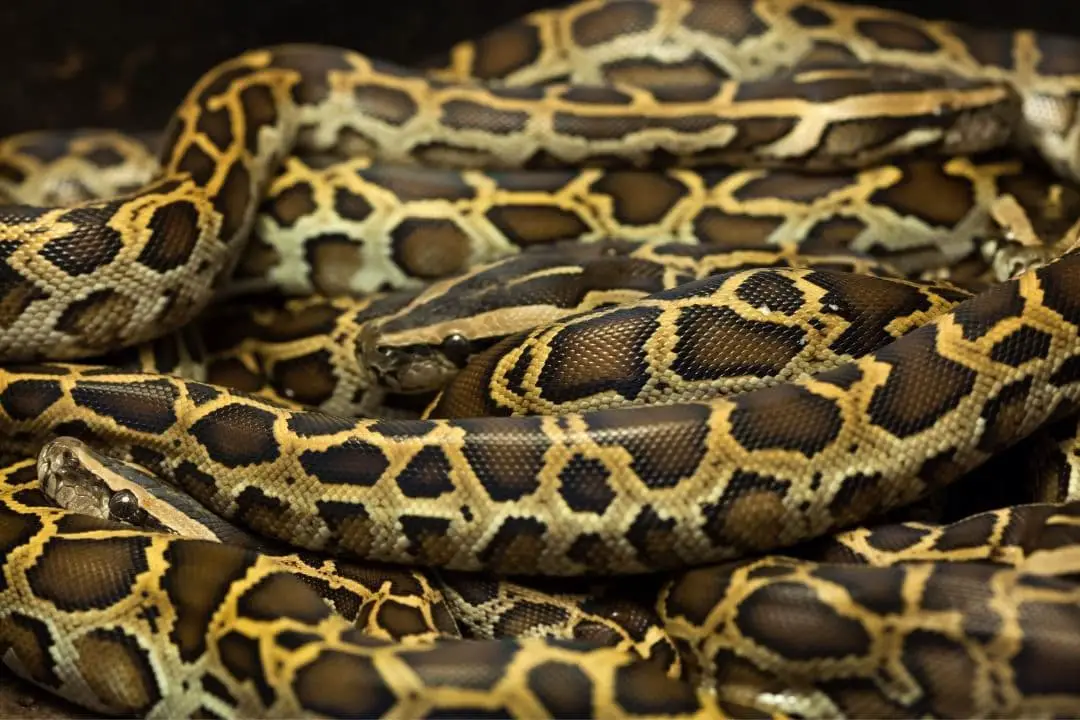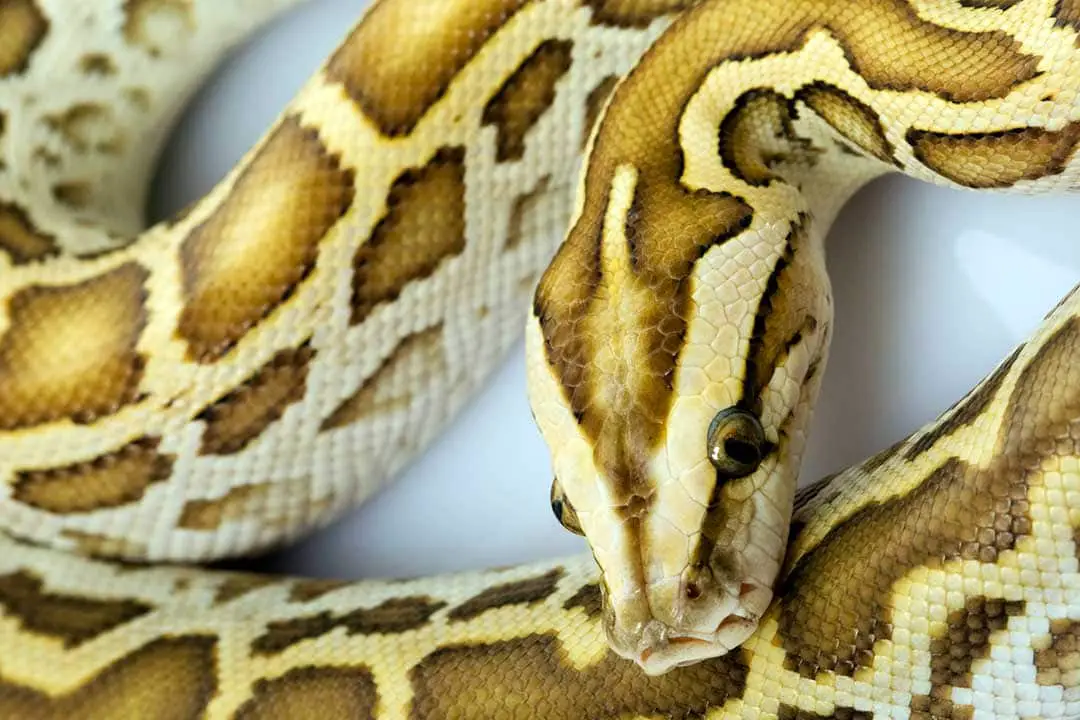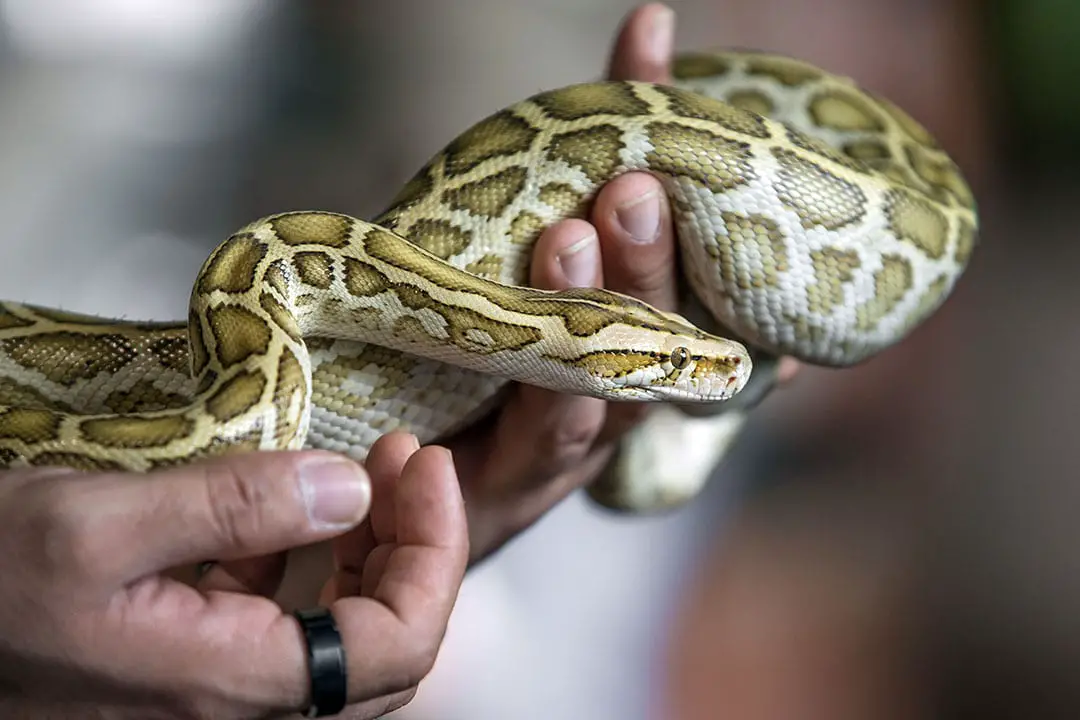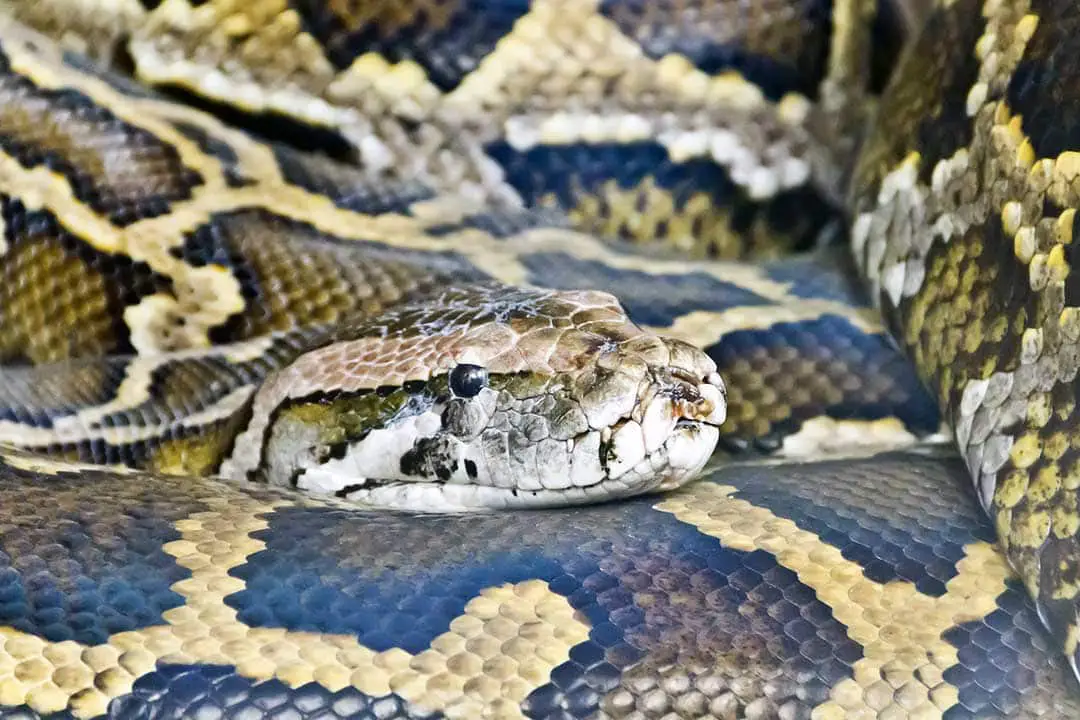The Burmese python (Python bivittatus) is known for being one of the largest pet snakes.
If you want one but are put off by the size, you may be interested to find out that some localities have a dwarf subspecies (P. b. progschai) of these snakes.
This guide will show you some ways that these dwarf varieties differ and any care differences you need to know about.
Be sure to check our main care guide for the burmese pythons before you decide to commit.
One important note is that some less than reputable breeders will claim a snake is a dwarf when it isn’t. Be sure you do your research and be prepared in case your snake ends up larger than you expected.
About Dwarf Burmese Pythons
Dwarf Burmese pythons are animals from the islands of Java, Bali, and Sulawesi. Depending on the island, most snakes will be under 8.2 feet.
This makes them easier to house and handle than the typical snake. This is a subspecies, so they are distinct from mainland forms.
They are genetically different enough to be a recognized subspecies but not different enough to form a separate species.
They can interbreed with the mainland snakes, but we will cover them in depth in a specific subsection. These animals are great examples of insular dwarfism, where a large animal becomes smaller when a population develops on an island.
If you want to be sure your snake is small, make sure it is a pure example of the subspecies. They may be sold as dwarf Burmese pythons or be listed by their trinomial designation.
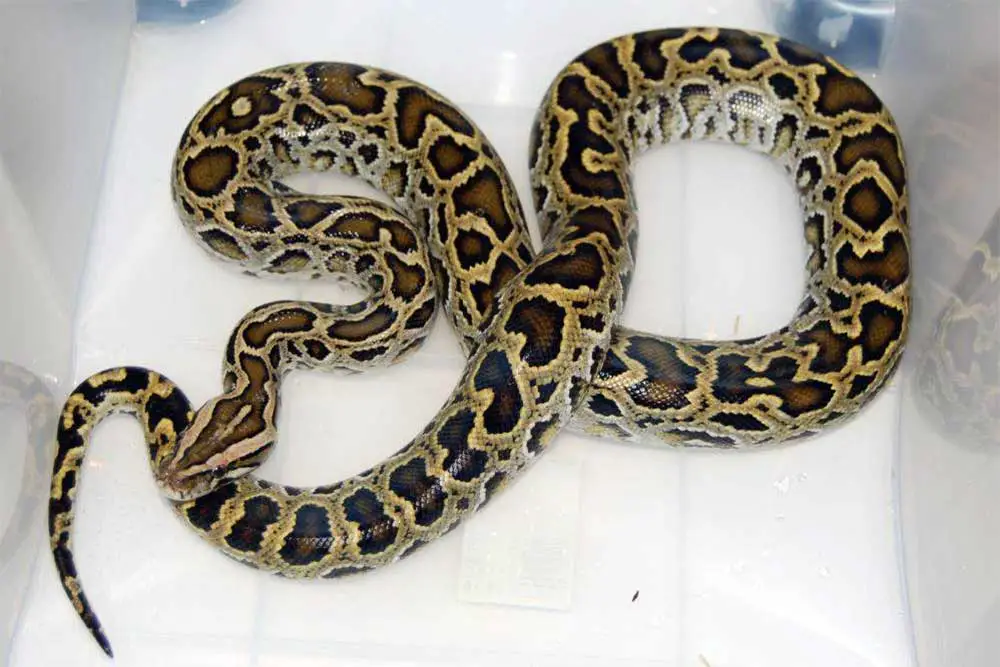
Be careful when you source pure snakes since you could get a wild-caught snake. As we will cover in the temperament section, wild-caught dwarf Burmese pythons are very willing to strike at you.
Besides the risks of introducing parasites to your collection, wild snakes may be trafficked illegally. Some animals will not adapt to captivity and may die.
Even species that typically do well in captivity can die of taken from the wild. Wild snakes are also typically less healthy. Illegally trafficked snakes threaten wild populations by removing animals from the wild.
They are also frequently stressed and sick by the time they reach your country. Most wild-caught snakes die during transport or soon after.
Size
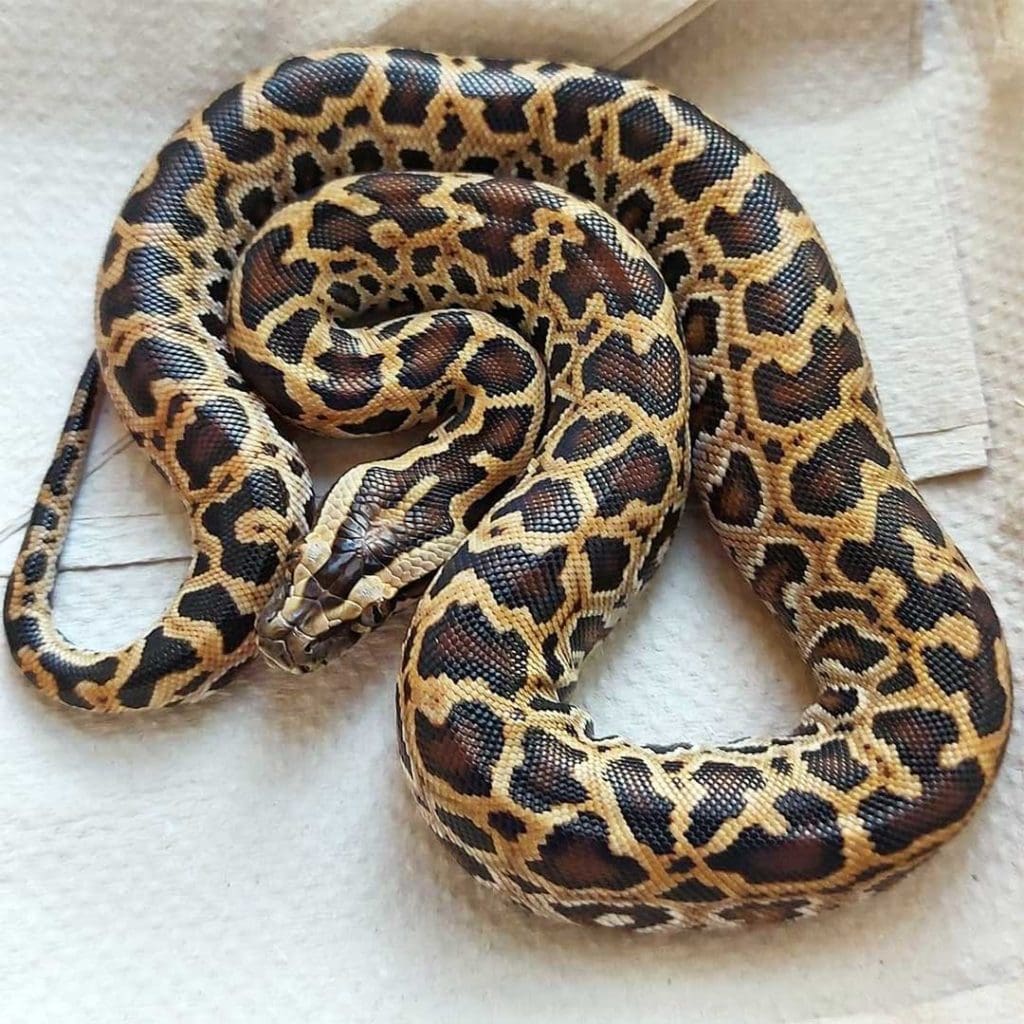
How small is a dwarf burmese python?
A dwarf burmese python (python bivittatus progschai) will be under 8 feet long. Males will typically be smaller at an average of 4-5 feet. Females will be between 5.5-6 feet on average. They are typically slimmer in proportion to their mainland cousins.
Hybrids called half dwarfs can be more variable, so be sure you prepare in case your hybrid ends up as a giant. Pure dwarfs will be lighter and smaller, but hybrids can be much larger and heavier.
They are typically in between their parents in length and thickness. Some breeders will also lie and claim a pure mainland snake is a hybrid if it is smaller than average.
It may still end up as a giant, so only buy from a trusted breeder. Half dwarf pythons can be 9-10 feet, so be sure you can handle that if you choose a half dwarf.
Smaller percentages will be much larger.
Once you get past half assume you will have a full-sized mainland Burmese python.
If your snake is smaller, then you can be pleasantly surprised rather than scrambling to house a larger snake or even having to rehome your pet after a few years.
Temperament
Temperament is the big point that turns people off the dwarf Burmese pythons. Wild-caught animals are notoriously grumpy and willing to bite.
The first and second generations can also have this personality. Once you get down to the third generation they can be just as tame as a mainland Burmese python.
The difference is likely at least partly because of the fact that most Burmese pythons in captivity are many generations from the wild.
Many breeders will choose to breed snakes that are calmer since they are easier to handle and sell. Half dwarf snakes will also tend to be calmer than a first or second generation dwarf.
The number of generations is typically marked as F(number) in the listings, so look for F3 or later if you want to make sure you have a calm pet.
Babies will be nippy but they will tame down if you are patient. Just be gentle and work with them. If you are considering any Burmese python, you should already understand how to handle and tame a snake.
The main benefit of a dwarf Burmese python is needing less space and smaller prey on average. The care requirements and expertise needed puts these snakes as pets only for advanced keepers.
Remember that snakes are also individuals. Some may be sweet while others are grouchy and likely to bite.
This depends on the individual animal and even the same keeper can end up with wildly different personalities in their pets.
Enclosure Size

Generally speaking, you will need a smaller enclosure for a dwarf snake.
Aim for having it at least the length of the animal by half its length in width and height. This offer enough space for your pet to exercise.
More floor space is generally better for Burmese pythons, but these snakes do enjoy climbing. They also need big hides and a water tub, so aim for more floor space.
Custom Reptile Habitats – PVC & Aluminum Enclosure – 72 L x 24 W x 36 H
- Sliding glass doors – Enjoy this big viewing area with crystal clear 1/4 inch Tempered glass that won’t scratch or discolor over time
- Stunning design with super strong Anodized Aluminum frame – Looks great in your home and will never rust or peel
- Real PVC panels – The preferred choice for reptile enclosures. Holds high humidity and will never break, rot or catch fire

For an average male dwarf snake, this 6-foot example is great. If your snake ends up at the upper end or you want to offer more space, this 8-foot example is perfect. If you have a hybrid that ends up larger than 8 feet, look into a custom or DIY enclosure.
You want something at least as long as your snake with plenty of floor space.
Dwarf burms are heavy-bodied animals that like to rest in a flat coil. They need much more space than you would think. Our main care guide can help you if you have a larger snake than you expected.
The single biggest concern with these big snakes is making sure you have very secure locks. Make sure you assemble any enclosure well and inspect it at least twice a year to be sure your snake isn’t likely to escape.
Even dwarf Burmese pythons are incredibly powerful animals that force their way out of a poorly made or maintained enclosure.
You will need large hides and a water tub. You can use a dog kennel or cardboard box for a hide. Use heavy logs for climbing and hiding.
These are smaller animals, but they still need plenty of space and sturdy furnishings. It does not hurt to build up stronger than your dwarf burm needs.
This can make sure your snake does not break anything on accident. Some animals are prone to destroying weaker decorations.
Feeding
A pure dwarf needs smaller prey. Males that are around the size of a ball python will eat a similar diet.
Females may be larger and need bigger meals. The general rule for snakes is to feed no more than about 1.5 times the widest girth of the snake.
This may mean your adult snake will eat rats or Guinea pigs depending on its size. Hybrids may need rabbits or chickens just like the larger mainland pythons.
Feeding frequency is identical to the larger pythons, but monitor the body condition closely. Ambush predators like Burmese pythons are easy to overfeed.
Look for fat deposits on your snake or a heavy weight for its size. This means you need to feed less often. If you can see its spine or ribs, feed more often.
Increasing prey size can also help, but be careful not to offer anything too large. Large prey items will be regurgitated and this can harm your snake.
Aim for smaller meals and adjust the frequency.
Try to get your snake used to weekly weighings so you can monitor its growth.
You can use a string to estimate length as well, just place it along the spine and use that to measure since getting a snake to sit still in a straight line is very difficult.

Frozen prey is still the best choice since it is most convenient for you and safer for the snake. If you happen to breed feeder rodents, we recommend learning how to euthanize feeder rodents to help avoid injuries to your snake.
Micedirect Frozen Rats X15
- Direct from the producer
- Packed in dry ice, delivered by FedEx
- These feeder Rats for snakes are put to sleep with Co2 so they never suffer
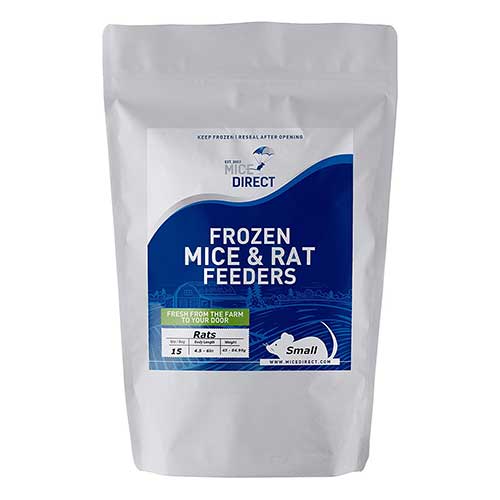
Cervical dislocation or gas euthanasia tends to be recommended for feeder rodents, but talk to a vet to learn the best method. If you need live feeders for a stubborn snake, look for local rodent breeders or reptile stores.
They may have rodents in the right size for your pet. Live animals can be a bit harder to judge, so aim for slightly smaller sizing to reduce the risk of regurgitation.
Frozen prey can be sourced online and shipped to your door. Micedirect is a great option for many types and sizes of feeder animals.
Price and Where to Buy
Price is the big kicker for these snakes. They are typically much more expensive than a normal Burmese python and most other snake species.
Half dwarfs are typically around $400-700 depending on the morph. Quarter snakes tend to be cheaper unless they are a rare morph. Pure dwarf burmese pythons are rare and can go for over $1000.
Most people breed for the morphs by breeding with mainland snakes. This means that pure snakes are rare and valuable. Breeders can be found in the US on Morph Market, but be sure to read the reviews of the breeder since it is a marketplace.
These snakes are much cheaper in Europe in general and the UK. You can find them for under €200 if you are fine with a half dwarf.
Pure dwarfs can be found for under £400. Prices are highly variable thanks to availability. You may lay much more if the snakes are in demand. Be sure to factor in shipping as well since these are large animals. Local reptile sites often have classifieds for snakes.
This is a good option for those in the UK. Check your local boards and look into any Burmese python breeders in your region. Some may be planning a dwarf burms breeding but don’t have any stock up yet.
If you see a rehoming ad, be careful since the owner may have been lied to about what the snake is. If the snake is larger, it may be a full Burmese that was claimed to be a dwarf to make the animal more expensive.
Be careful and always look up reviews of a breeder on third-party sites. You can also ask for advice on breeders on local forums.
They may be able to guide you to someone local you may not have found otherwise. Since the reptile trade started offline, many breeders aren’t online.
They may only sell to locals or at reptile shows. Be sure to check these venues including local reptile stores when you are trying to find an animal.
Longevity

How long does a dwarf burmese python live?
The lifespan of these snakes is likely similar to their mainland counterparts. You can expect a dwarf Burmese python to live for around 20 years.
Hybrids will likely live around the same time unless they have particularly bad genes. These snakes will live for decades, so be sure that you can commit to this lifespan.
Being rehomed is stressful for snakes so it should be minimised if possible. One factor that can seriously affect the lifespan of these snakes is overfeeding.
Obese snakes have reduced lifespans. This is because of how fat is stored in snakes.
By the time you see external fat on Burmese pythons, the snake is already suffering with internal fat deposits.
People frequently feed these snakes exactly like a massive mainland python, and the snake suffers for it. Always tailor meals to the size of your pet.
Half Dwarfs
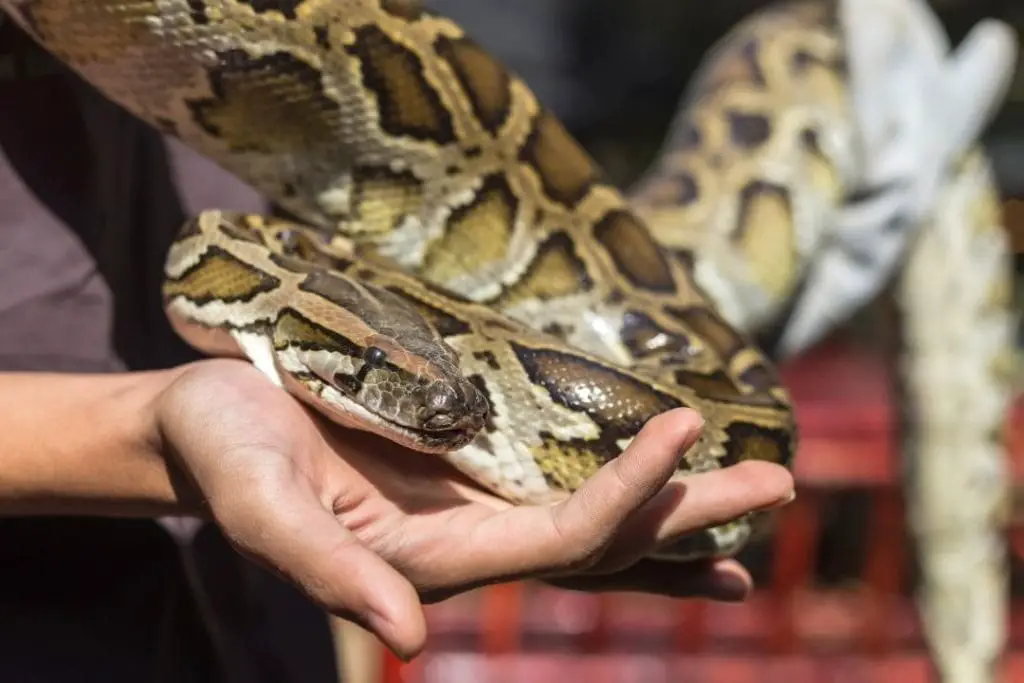
Half dwarfs are snakes that have either one dwarf and mainland Burmese pythons as parents or two half dwarf parents. A true half will be smaller than a pure mainland but at least a foot longer than a pure dwarf.
They can easily be 9-10 feet though, so they still need a huge enclosure and two people to handle them. Be careful, since hybrids can be very variable.
If your snake has any adult siblings from the same parent, ask the breeder for their sizes.
This can give you an accurate range for your potential snake. If you decide to buy a half dwarf, be prepared for any size just in case.
Even relatively consistent snake species can produce the odd giant, so no one can guarantee the snake’s adult size.
Avoid overfeeding the snake and you may keep your per smaller.
Overfeeding a normal burm can result in a larger animal, same thing for a dwarf. One note is that these hybrids tend to have calmer personalities. Many reptile owners describe them as puppy tame.
This can be an exaggeration, but they can be very calm.
Of you like mainland Burmese temperament and want it in a smaller package, look for a half dwarf. If you want a calm snake, a hybrid can be a great option.
Thos is particularly true if you can only find F1 or F2 captive dwarf Burmese pythons. You might decide a calmer snake is worth having a larger snake.
So long as you have the space you can pick whatever snake matches your needs. There are smaller percentages that can be cheaper, but they will be larger snakes. Expect them to be close to normal Burmese pythons in size.
Super Dwarf Burmese Pythons
Super dwarf Burmese pythons do not exist. The term comes from reticulated pythons that have much smaller localities that may be called super dwarfs.
This is not true of Burmese pythons. If you see someone selling a super dwarf Burmese python, they don’t know what they have or are lying.
They may also have a cross-bred animal. It is possible to breed reticulated pythons to Burmese pythons. Be careful since hybrid animals like this are highly unpredictable.
It can be hard to tell what the animal may end up like in terms of size and temperament. Stick with buying dwarf burms with known genetics.
Are There Dwarf Burmese Python Morphs?

Yes, there are if you are fine with a half dwarf or less. The hybrids have the most variety since you can find many of the same morphs available.
Recessive traits can be harder to find, but a good idea if you want a morph is to follow breeders on social media.
This can help you know of any future breeding projects in advance. You can find hypo, albino and more in half or quarter dwarf Burmese pythons.
Pure dwarf snakes are currently only normal since crossing them out for morphs means they are no longer pure.
Sources
Barker, David G and Tracy M. Barker. “The Distribution of the Burmese Python, Python molurus bivittatus.” (2008).
Jacobs, H.J.; Auliya, M.; Böhme, W. (2009). “On the taxonomy of the Burmese Python, Python molurus bivittatus KUHL, 1820, specifically on the Sulawesi population”. Sauria. 31 (3): 5–11.
Conclusion
We hope this has helped you learn more about these dwarf giant snakes.
If you want to own one of these, please do a good a mount of research and prepare for a bigger snake than you thought. Avoid wild caught animals as to not participate to their habitat degradation.
Burmese pythons became an invasive species in south florida, and can be dangerous to smaller pets and children, so make sure you get a secure enclosure!
If you have any questions or comments, please drop them below.
